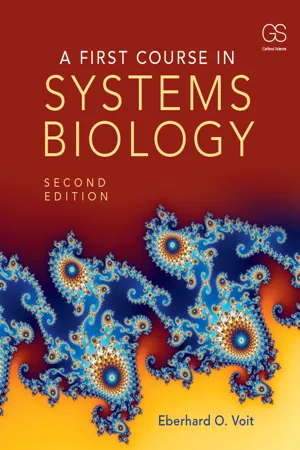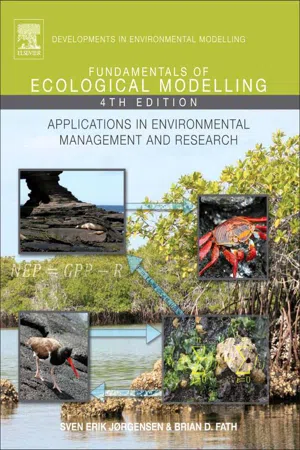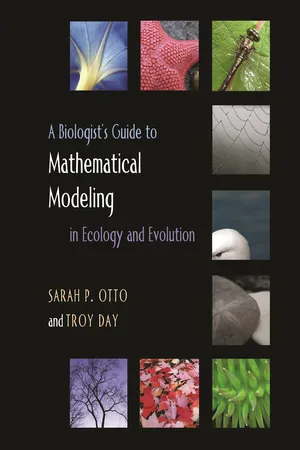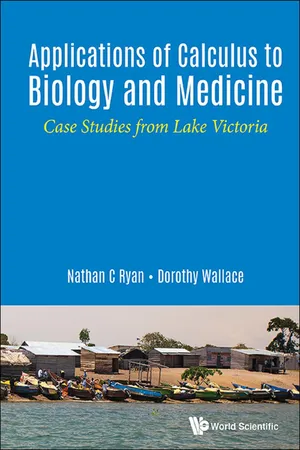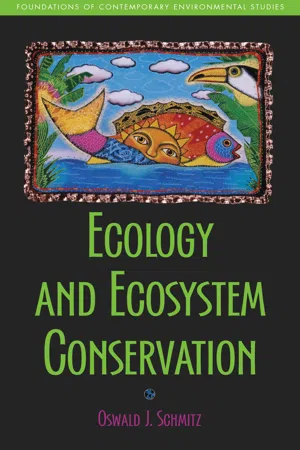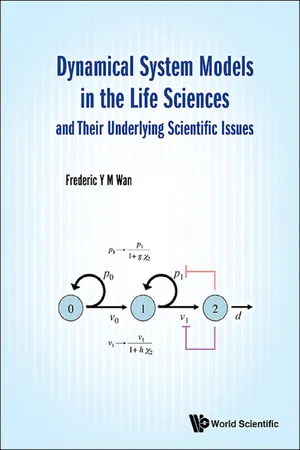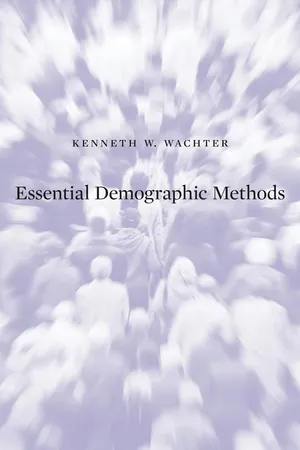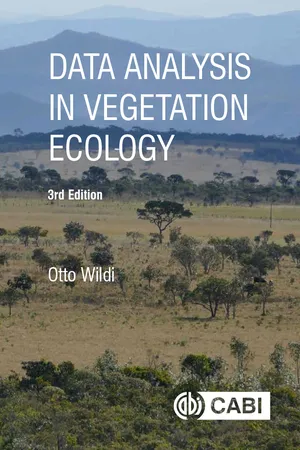Biological Sciences
Logistic Population Growth
Logistic population growth refers to the pattern of population growth in which a population initially grows exponentially but eventually levels off as it reaches its carrying capacity. This model takes into account limiting factors such as food, space, and competition, and is often represented by an S-shaped curve. It is a key concept in understanding population dynamics and ecological sustainability.
Written by Perlego with AI-assistance
Related key terms
Related key terms
1 of 4
Related key terms
1 of 3
12 Key excerpts on "Logistic Population Growth"
- eBook - ePub
- Eberhard Voit(Author)
- 2017(Publication Date)
- Garland Science(Publisher)
1 ]. Furthermore, population studies by their nature consider large numbers of individuals, which leads to an averaging of individual variability. Thus, in simplified growth models, all individuals or members of the population are essentially the same, and one studies their collective behavior.The logistic growth function, which we discussed in some detail in Chapter 4 , is a great example of these approximation and averaging effects. By describing millions of cells, aspects of individuality and diversity, which can actually be quite significant even in bacteria, are averaged away, and the populations follow simple, smooth trends (as, for example, in Figure 10.1 ) that are characterized by just a very few population parameters such as the growth rate and the carrying capacity (see below). This approach might seem overly crude, but it is very powerful, as the analogy with an ideal gas shows: while it is impossible to keep track of every gas molecule and its interactions with other molecules or the wall of the container, physicists have developed surprisingly simple gas laws that relate volume, pressure, and temperature to each other in a very accurate manner.Figure 10.1 Growth of a bacterial colony. The colony, measured by its area on a Petri dish, was assessed over time (red dots). The logistic function N(t) = 0.2524/(e−2.128t + 0.005125) (blue line; see Chapter 4 ) models the data very well. (Data from Lotka A. Elements of Physical Biology. Williams & Wilkins, 1924.)10.1 Traditional Models of Population GrowthThe exponential and logistic growth functions are not the only growth functions. In fact, very many growth laws have been proposed over the past 200 years, either as explicit functions or as ordinary differential equations (ODEs). One example is the Richards function [7 - eBook - ePub
Fundamentals of Ecological Modelling
Applications in Environmental Management and Research
- S.E. Jorgensen(Author)
- 2011(Publication Date)
- Elsevier(Publisher)
All three assumptions are unrealistic and can be strongly criticized. Nevertheless, several population phenomena can be nicely illustrated by using the logistic growth equation.Illustration 5.1
An algal culture shows a carrying capacity due to a self-shading effect. In spite of "unlimited" nutrients, the maximum concentration of algae in a chemostat experiment was measured to be 120 g/m3 . At time 0, 0.1 g/m3 of algae was introduced and 2 days after a concentration of 1 g/m3 was observed. Set up a logistic growth equation for these observations.Solution
During the first 5 days, we are far from the carrying capacity and we have with good approximations:and since the carrying capacity is 120 g/m3 (C = algae concentration), we have:Integration and use of the initial condition C(0)= 0.1 yield whereThis simple situation in which there is a linear increase in the environmental resistance with density, that is, logistic growth is valid, seems to hold well only for organisms that have a very simple life history.In populations of higher plants and animals that have more complicated life histories, there is likely to be a delayed response. Wangersky and Cunningham (1956, 1957) have suggested a modification of the logistic equation to include two kinds of time lag: (1) the time needed for an organism to start increasing, when conditions are favorable, and (2) the time required for organisms to react to unfavorable crowding by altering birth and death rates. If these time lags are t − t1 and t − t2 , respectively, then we get:(5.8)Population density tends to fluctuate as a result of seasonal changes in environmental factors or due to factors within the populations themselves (so-called intrinsic factors). We will not go into details here, but will just mention that the growth coefficient is often temperature dependent and since temperature shows seasonal fluctuations, it is possible to explain some seasonal population fluctuations in density in that way. - Sarah P. Otto, Troy Day(Authors)
- 2011(Publication Date)
- Princeton University Press(Publisher)
R = 3.5 (long-dashed curve). These curves suggest that the reproductive factor of the pheasants was nearly 3 per year.3.2.2 Logistic Population Growth
Many factors slow the rate of growth of a population, including declining resource availability, increased predation pressure, and a higher incidence of disease. The logistic model in discrete time describes these processes indirectly by assuming that R declines with increasing population size. The exact form of this decline has been modeled in many ways (see Problem 3.4). The standard logistic model assumes that the number of surviving individuals per parent declines linearly with population size (Figure 3.3 ).Writing the reproductive factor as R (n ) to emphasize its dependence on the population size, R (n ) starts at (1 +rd) when the population size is near zero and there is no competition for resources. The parameterrdis known as the intrinsic rate of growth because it measures whether the population tends to grow (rd> 0) or shrink (rd< 0) when there is no competition for resources. As the population size increases, the reproductive factor decreases and eventually reaches a point where each individual exactly replaces itself; the population size at this point is called the carrying capacity K , because it is the maximum population size at which the population can sustain itself. From Figure 3.3 , the equation for the line describing the reproductive factor as a function of population size isFigure 3.3: The number of surviving individuals per parent. The logistic model assumes that the number of surviving individuals declines linearly from a maximum of 1 +rdwhen n (t ) is zero (the intercept) to one when n (t ) is K . The slope of the line is given by the rise (−rd) over the run (K- eBook - ePub
Applications of Calculus to Biology and Medicine
Case Studies from Lake Victoria
- Nathan C Ryan, Dorothy Wallace;;;(Authors)
- 2017(Publication Date)
- WSPC(Publisher)
The logistic equation we just studied is a far better model of how organisms grow than exponential growth was, unless the population is at the very start of its growth pattern. Even though the fit to Bagrus catch data was not very good, the logistic model captured one very important aspect of it: not growing without bound. No species can grow without bound since in every ecosystem there are limited resources. The logistic model therefore has another advantage: it builds in the effect of limited resources explicitly, so that the mathematical consequence is causally tied to our hypothesis of what causes it. We always seek this elegance in a model. We want our hypotheses clearly expressed in the equations we create, and we want the solutions to those equations, which illustrate the consequences of our hypotheses, to match our observations of nature.Mathematically, here is a way to think about the Bagrus data. If we compare the exponential model to the data, the error in predicting a data point from the model gets larger and larger as time goes on. The exponential function keeps increasing but the data are bounded, so the error goes to infinity with time. The logistic curve, being bounded itself, results in an error that, although large, is bounded over time. One must admit that the improvement from an infinite error to a finite one is impressive, even though the finite error may (as in this case) be very large and the fit-to-data is not at all convincing.Populations that really do grow in limited environments with no other forces acting on them do indeed obey the logistic equation fairly closely. It may be hard to imagine such a situation in nature but it is easy to imagine setting one up in a laboratory. Small organisms such as bacteria or insects that have a constant source of nutrients can actually be observed to grow according to the logistic equation, as in [5 , 2 , 3 - Oswald J. Schmitz(Author)
- 2013(Publication Date)
- Island Press(Publisher)
For example, to those who wish to avoid car accidents or the destruction of ornamental garden plants, even one deer may be too many. Those who oppose killing deer to reduce their population size, counterargue that the presence of one or a few individual deer within a local area is insufficient evidence to claim an overabundance problem. Either way, such values may or may not have any relation to the number of deer the natural environment can support. In order to have productive policy debates, we need to disentangle biological principles from value judgments. This requires first understanding basic principles of population dynamics and factors that may limit population size followed by application of these principles to reconcile human values of abundance with the biological capacity of the environment to support a population.Simple Population Growth
Most species are capable of reaching huge abundances. Typically, however, they do not. Why? To answer this question, we need to consider the fundamental properties of population growth.In discussing the life-as-a-game metaphor in chapter 2, I noted that the point of the game is to contribute as many descendants as possible to future generations. Thus, if there are two phenotypes that differ in their rate of survival and reproductive output (fitness), natural selection will favor the one that has the higher net survival and reproduction. This is because that phenotype produces genetic copies of itself at a higher rate than the other phenotype. Fitness, then, is a measure of that rate of increase in the abundance of a phenotype.This kind of population growth is known as geometric or exponential growth because the number of indi- viduals in the population multiplies rather than adds over time. This simple geometric process is what gives populations the potential to reach prodigious abundances.Suppose we now counted the number of individuals in a population of a phenotype after each generation and plotted that number against time (figure 4.1a- eBook - ePub
Models for Life
An Introduction to Discrete Mathematical Modeling with Microsoft Office Excel
- Jeffrey T. Barton(Author)
- 2015(Publication Date)
- Wiley(Publisher)
5 DENSITY-DEPENDENT POPULATION MODELSIf we project exponential population growth far enough into the future, it eventually becomes unrealistic because the population continues to grow without bound. We do not really expect the Yellowstone grizzly population to reach, say, a billion bears; yet, if we rely uncritically on our exponential model, eventually that is what we will see.Real populations seldom exhibit exponential growth for long. Certainly there are many examples where populations do grow exponentially for a time, but both experience and common sense tell us that eventually the growth must taper off. As overcrowding develops, resources like food, water, and shelter become more and more scarce, diseases spread more easily, and as a consequence it becomes more difficult for the population to continue growing. Models that take these growth-limiting effects into account are said to be density dependent.5.1 THE DISCRETE LOGISTIC MODEL
We begin by assuming that for any population there is a maximum number that a given environment can support. This maximum number is called the carrying capacity, and we follow convention by denoting this number by K. We should note that the carrying capacity depends both on the particular species and on the particular environment in which it is found. A small pond, for example, will have a smaller carrying capacity for goldfish than a large lake—it is not just the goldfish themselves that determine the carrying capacity. Similarly, a lake will have a larger carrying capacity for minnows than for catfish.Our task in this section is to build a DDS that models a population when we know its growth is limited by the carrying capacity of its environment. Before we attempt to write down the DDS, we give some thought to the features that such a model should have. - eBook - ePub
- Charles Krebs(Author)
- 2008(Publication Date)
- CSIRO PUBLISHING(Publisher)
Cohen 1995 , Appendix 3.)Any discussion of carrying capacity must involve the concept of sustainability, which refers to the use of resources in a manner that can be continued indefinitely in the future. Sustainability is a critical issue for this century because humans are running into limits that are set by the biological resources of Earth. We will consider sustainability further in Chapter 21.Like all populations, human populations are subject to the rule that critical resources limit population growth sooner or later. The next four chapters explore how these limitations operate in plant and animal populations.SUMMARY
Populations change over time, and a variety of population growth models have been proposed to quantify these changes. The most basic model describes geometric growth, which can occur for only a short time. Therefore, most realistic models account for regulated population growth. The most surprising result of population models is that a great variety of population changes—from stability to unpredictable fluctuations—can arise from very simple assumptions. Data from natural populations illustrate that few populations are stable and wide fluctuations are common.No population can increase without limits. Many studies have analyzed the environmental factors that stop population growth and cause population decline. Reproduction, death, immigration and emigration are all involved in changing population size. Pest control and the conservation of declining species are two practical examples of the need to understand the causes of changes in populations in size over time.The human population is increasing rapidly, and this increase must come to an end during this century, because humans are not exempt from ecological laws. Sustainability is essential for all populations, including humans. The carrying capacity of Earth for humans may already have been exceeded, and the transition from a growing human population to a stable one is one of the most important problems of this century. - Frederic Y M Wan(Author)
- 2017(Publication Date)
- WSPC(Publisher)
0 < 0 is not relevant since population size cannot be negative.) These conclusions are certainly more consistent with our understanding of growth and decline of the human population than the linear (or constant) growth rate model (leading to exponential growth). Instead of unlimited growth, the new model predicts that the human population should tend to a limiting population size eventually.3.1.4 Validation and model improvement
As such, the logistic model is seen to be more appropriate and reliable for a longer time interval for the human population on Earth. More generally, the logistic growth model should be adequate for population growths that are autonomous with the following three properties for its growth rate function:For more quantitative information beyond the qualitative observations in the preceding paragraph, we would need numerical values for the three parameters Y0 , a and Yc. These can be obtained by the method of least squares or other methods for parameter estimation using census data. We will not pursue such a discussion here. Instead, we note that, unlike Newton’s laws of motion, the properties (3.1.11) for the growth rate function do not hold for all evolving populations. A growth rate that is not monotone increasing even for small y is the “depensation growth rate” for some fish population. These are known to have a threshold population size for extinction Ye; their growth is more adequately modeled by the separable equationwhere a, Yeand Ycare three constant parameters characterizing the instantaneous rate of change of the population in addition to the initial population Y0 . From the perspective of Taylor’s theorem, the right-hand side of the new model ODE (3.1.12) is a four-term Taylor polynomial approximation of f(y) (that is cubic in y- eBook - ePub
- Kenneth W. Wachter(Author)
- 2014(Publication Date)
- Harvard University Press(Publisher)
Later, methods in Chapter 2 will let us calculate population size from formulas for R. All these formulas include parameters, here called c, f, and g, which specify a particular case from a family of similar cases. Two families of cases which can represent accelerating population growth are treated in the exercises: K (t) = exp((f / g)(e gt − 1)) and K (t) = (f /(f − t)) 1/ g. In this section we work through a famous model in which population growth responds to available resources, the case of Logistic Growth: To calculate R from K (t), we first take logarithms, yielding log K (t) = gt − log(e gt /c + f). The slope of the log of a function is the slope of the function divided by the value of the function, so When the constant f is positive, K starts out smaller than c at time zero, R is positive, and K increases. If K starts out much smaller than c, the population starts out with nearly exponential growth. But as K grows toward c, the growth rate heads toward zero. Population size levels out at c. We think of c as something like the carrying capacity of the environment and 1 − K(t)/c as something like resources available to sustain growth. In the logistic model, population size approaches an equilibrium level equal to c. A negative value of f means that the starting population is above the sustainable level c. Then growth is negative, and the population trends downward to its equilibrium. The logistic formulas give one example of population curves that could arise from demographic feedback along lines proposed by Rev. Thomas Malthus in his 1798 work An Essay on the Principle of Population and later editions, a founding work of demographic theory. In a stylized version, we can picture larger population size and a larger supply of labor leading to lower wages. We can also picture lower wages leading to higher death rates and in some settings to lower birth rates. In this way, high population sizes can lead to negative growth rates, forcing population size down - eBook - ePub
- Otto Wildi(Author)
- 2017(Publication Date)
- CAB International(Publisher)
C , the carrying capacity:As the state variable X approaches the carrying capacity, C , growth becomes zero and the population stops growing. Equation 11.6 does not explain why the carrying capacity occurs. But one could think, for example, of an open water pond which is overgrown by Lemna (duckweed). At the beginning there is no limiting resource (open space, in this case) but once the pond is overgrown growth must stop.As for exponential growth the explicit solution to the differential equation (Equation 11.6) is known (Maynard Smith 1974). But logistic growth is another good example to demonstrate numerical integration. Although there are numerous functions available in R to support this I explain how explicit calculation is done. The three basic steps involved remain the same for even very complex models:- Set up the time frame (beginning, end, time step length), define parameters (growth rates, carrying capacity, other) and state variables at the begin of simulation (initial conditions).
- Program a time loop (a for statement in R , see below). Embedded in this are the differential equations and functions for numerical integration.
- Establish model output. This may include text, but frequently graphical display.
For the logistic growth equation we simply write this down in R :For time t a vector is prepared using function seq() with three parameters: the first giving the first element of the vector, the second the last element and the third is the increment used for the elements in between. The content of this vector then is t = (0, 1, 2, . . ., 99). Function rep() is used to initialize the state vector x and it repeats 0 nt times.Figure 11.3: Simulating logistic growth using two different time step lengths. Carrying capacity is c = 20.Then follows the second step, assessing the time loop (using function for()) with nt steps of computation. Inside the curly braces is the differential equation (Equation 11.6) and a line for numerical integration (Equation 11.5): - eBook - ePub
Growth Curve Modeling
Theory and Applications
- Michael J. Panik(Author)
- 2014(Publication Date)
- Wiley(Publisher)
P is, more often than not, highly nonlinear.) So while most population growth models tend to be based on the logistic equation, some popular extensions of the logistic architecture are the subject matter of the ensuing sections.10.6 BEVERTON-HOLT MODEL
The Beverton-Holt (B–) (1957) model is a discrete-time equation used in fisheries management that describes a connection between “stocks” and “recruits”–the so-called stock-recruitment (S–R) relationship. We may view the spawning stock (S ) or “stock” for short as the portion of the fish population wherein reproduction occurs. Recruits (R ) are the entrants to the stock of fishes (the entry process itself is called recruitment ). Recruitment can be defined in terms of (i) the age of the fish (e.g., fish surviving to age one year are said to have been recruited to age one year) and (ii) the size of the fish (fish that survive to a “catchable size” are said to have been recruited to the fishery).Various types of S –R relationships may be considered. First, an S –R relation may be density independent (R /S = a = constant –the ratio of recruits to spawners is constant and independent of the number of spawners, where a is the density-independent parameter). Second, the connection between S and R may be described as density dependent. Such relationships may be specified as:Figure 10.81. Compensatory –per capita recruitment declines with increasing size of the S .2. Overcompensatory –per capita recruitment declines with “high” values of S (e.g., when disease outbreaks occur due to overcrowding).3. Depensatory –per capita recruitment actually decreases when S falls below a certain level (the Allee effect). - eBook - ePub
Understanding Nature
Ecology for a New Generation
- Louise M. Weber(Author)
- 2023(Publication Date)
- CRC Press(Publisher)
Chapter 17 . In brief, the neutral theory approaches any ecological situation with the premise of no equilibrium, then determines if the accompanying data show otherwise. This approach applies to all ecological interactions, not just population growth. For instance, instead of assuming that predators and prey affect one another because that is what past theory suggests, the neutralists advocate an expectation of no interaction, then make a determination based on whether this hypothesis is violated. Interestingly, equilibrium states have been found for populations, but in small patches for short periods. Biotic processes as hypothesized by the equilibrists may indeed be at work as predicted, but in a constantly shifting mosaic of small patches.The equilibrium debate in population ecology diminished in the 1980s as practitioners began to turn toward conservation biology, the growth of rare species, and other practical applications. The equilibrium debate, however, migrated to community ecology, where it became an argument about interspecific interactions. Chapter 17 further describes this development of the equilibrium debate.THINKING QUESTIONS- Why is the model named “logistic?” Use the internet to find out.
- Find examples of population growth for other species.Data from Christmas Bird Counts are available via internet.How might data for bird species collected during annual Audubon Club counts be somewhat biased?
- For the examples in this chapter that show boom and bust or erratic growth patterns,such as Red-breasted Nuthatch,examine the diet,life histories,and habitat requirements to speculate on the immediate causes of variation from year to year.
- How can chance,randomness,patchiness,perhaps even chaos be responsible for patterns we see in nature like the formation of biomes?
- Mayflies have an adult emergence period of only a few days (earning the apt name Order Ephemeroptera).So many adults swarm at once that snowplow equipment has been used to remove piles of cast juvenile skins and dead adults from the streets of waterfront towns.Likewise,17-year cicada adults can be so numerous that dogs and other animals get sick from eating too many. Describe situations like this you have experienced.Does heavy predation on cicadas still leave enough adults to lay eggs and renew the cycle?
- Fox (2011 ) has relegated the r and K selected species idea to the list of Zombie Ideas in Ecology – ideas now hard to kill.Widely believed and intuitively appealing,they tend to persist,according to Fox,in spite of repeated theoretical refutations and whole piles of contrary facts. In his words,they are undead.As a solution,Read and Harvey (1989
Index pages curate the most relevant extracts from our library of academic textbooks. They’ve been created using an in-house natural language model (NLM), each adding context and meaning to key research topics.
Explore more topic indexes
Explore more topic indexes
1 of 6
Explore more topic indexes
1 of 4
